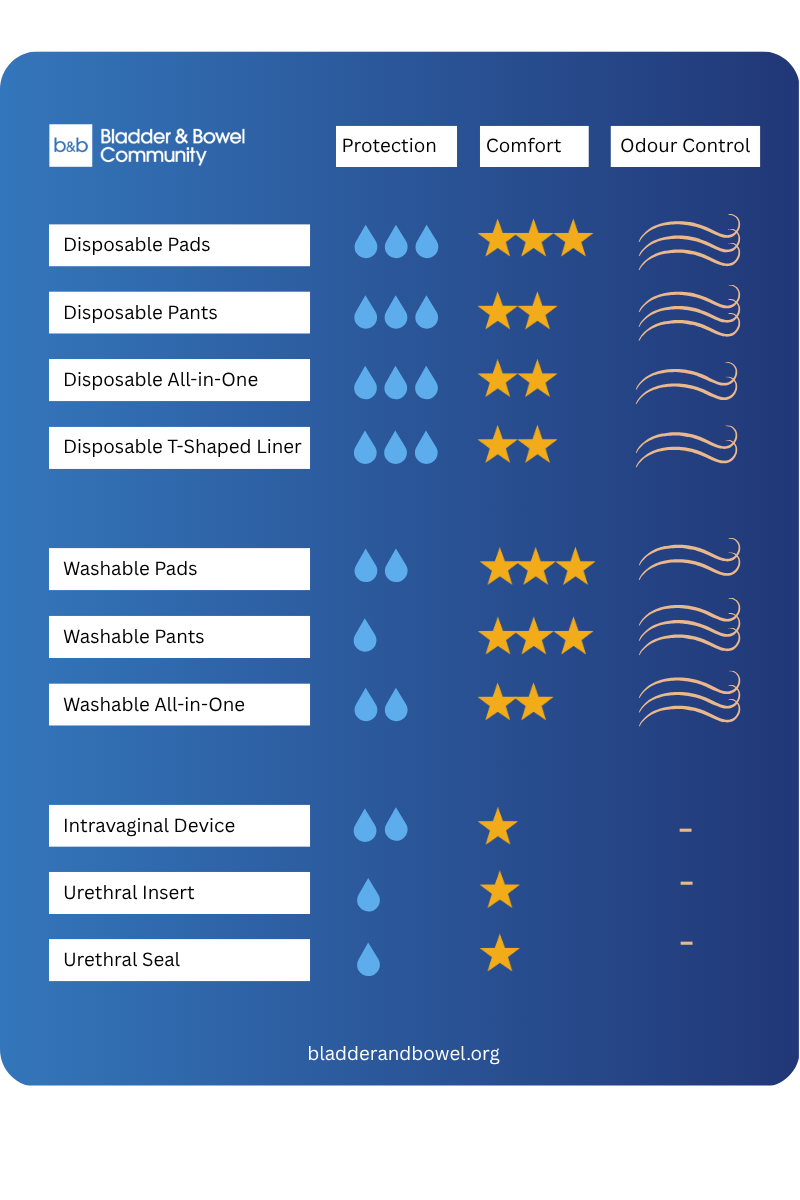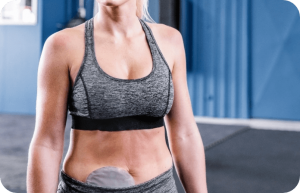There are many products on the market that can help you feel more comfortable and more confident when suffering from either bladder or bowel incontinence. There are some devices that are designed to either place pressure on the urethra or support the bladder neck in order to reduce stress incontinence. Incontinence pads or pants are a more popular choice for women. There are many types, sizes and absorbencies on the market as many are designed to be as discreet as possible.
In this article we’ll cover both devices and pads/pants to help you understand your options.
Urinary Devices for Bladder Incontinence
There are devices available that are designed to be inserted into the vagina and are usually only suitable for women who suffer from stress urinary incontinence. They cannot be used to contain or stem full urinary incontinence or a heavy flow. There is limited evidence that these products are effective, and urinary devices for stress urinary incontinence are not currently available on the NHS.
Intravaginal Devices
There are a few different types of intravaginal device, designed to improve stress urinary incontinence either by supporting the neck of the bladder or suppressing the urethra to reduce leaks. They don’t tend to work as well in women who suffer from mixed urinary incontinence. There are both single use disposable versions and reusable devices available on the market. Some women can find these uncomfortable to wear and they can cause soreness, bleeding and infections.
An intravaginal device is inserted via the vagina, similarly to a tampon. Some devices will come with an applicator to aid the process, but generally speaking these products are best suited to people with good hand/wrist mobility. Devices may degrade depending on their material so consider this as part of the cost when you are researching suitable products.
Incontinence Products for Runners
A bladder support device is a type of intravaginal device which aims to prevent leaks from stress urinary incontinence by supporting the neck of the bladder. This prevents stress-induced leaks, such as when you laugh, cough or sneeze, or take part in vigorous exercise like running.
Intravaginal devices can also work by compressing the urethra to prevent leaks, but can similarly be uncomfortable and increase your risk of UTIs.
Some people prefer intravaginal devices as they can avoid unwanted odours and uncomfortable absorbency pads. Bladder support devices for example may work well for runners or women with an active lifestyle, however, cause some discomfort so must be used with caution. If you experience any discomfort or bleeding, seek help from your GP.
Urethral inserts
A urethral insert is a small plug, inserted into the female urethra (as opposed to vagina) to guard against leakage. The device is removed prior to urinating and is only to be used for short term, due to the increased risk of urinary tract infections (UTIs). They can be uncomfortable and tricky to use, so are not a popular choice.
Traditional use of tampons is to stem menstrual flow but some women use them for stress urinary incontinence. NICE guidelines don’t recommend using tampons to manage urinary incontinence due to the risk of Toxic Shock Syndrome.
Urethral Seal Pads
A urethral pad can be used for short periods when you are more likely to leak (such as during exercise). The adhesive foam pad is placed over the urethral opening to offer a seal and prevent urine from passing through. The pad is then removed before going to the toilet to pass urine, and replaced with a new one, as needed. These seals can only be used to manage Stress Urinary Incontinence and carry the same risks of discomfort and increased risk of infection.
Types of Incontinence Pads
Incontinence pads are probably the most common and well known type of product available. They are intended to be used while waiting for a diagnosis, or for a treatment to work and are not intended for long term management. Incontinence pads are easily accessible either through your GP or from a retail store and are usually the first product tried by someone who has an issue with either bladder or bowel control.
What’s the difference between menstrual pads and incontinence pads?
Incontinence pads are different to menstrual pads, so don’t be tempted to use them for both purposes. Menstrual blood is thicker and leaves the body more slowly and less consistently and because the menstrual pad is designed for this level of absorption, it is better suited to trap the blood flow and clots that can occur.
Incontinence pads however are designed for a larger capacity of liquid which is thinner, and therefore more suitable for urine. They are more able to deal with incontinence leaks, and more efficiently capture and seal in up to 3500ml depending on the absorbency of the product. Some products are shaped for women specifically whilst others are unisex.
There are many different combinations to try depending on your preference from thinner, more discreet pads (for lighter leaks) through to highly absorbent disposable underwear. Incontinence pads are generally suitable for all, and with reusable washable versions now available, you can find something that suits your lifestyle and routine to catch unavoidable leaks. Some people can find them uncomfortable once they become soiled, and this can cause irritation to the surrounding skin. It is important to change your pad as quickly as possible after they become soiled to avoid sore, broken and irritated skin.
What’s the difference between menstrual pads and incontinence pads?
Incontinence pads are different to menstrual pads, so don’t be tempted to use them for both purposes. Menstrual blood is thicker and leaves the body more slowly and less consistently and because the menstrual pad is designed for this level of absorption, it is better suited to trap the blood flow and clots that can occur.
Incontinence pads however are designed for a larger capacity of liquid which is thinner, and therefore more suitable for urine. They are more able to deal with incontinence leaks, and more efficiently capture and seal in up to 3500ml depending on the absorbency of the product. Some products are shaped for women specifically whilst others are unisex.
There are many different combinations to try depending on your preference from thinner, more discreet pads (for lighter leaks) through to highly absorbent disposable underwear. Incontinence pads are generally suitable for all, and with reusable washable versions now available, you can find something that suits your lifestyle and routine to catch unavoidable leaks. Some people can find them uncomfortable once they become soiled, and this can cause irritation to the surrounding skin. It is important to change your pad as quickly as possible after they become soiled to avoid sore, broken and irritated skin.
Female Disposable Pads and Pants
Disposable pads and pants are the most convenient, easy-to-use and more discreet type of incontinence pad. Although not the most cost effective and environmentally-friendly, they are a good option short term. The pads come in different absorbances to contain from light to heavy leakage/soiling – with specific options for faecal incontinence.
Disposable pants have improved considerably in recent years and are designed to look like normal underwear but contain an absorbent pad in the crotch area. Some people find these can help manage leaks during the night.
For women they come in a variety of designs including:
- Disposable Incontinence Pads – these are better suited for those who have light to moderate bladder leakage. They can slip during strenuous activity so an alternative may be best considered during exercise. Some women use sanitary towels and these are generally cheaper than incontinence pads. Sanitary towels haven’t been designed to hold the same volumes of urine; they may also cause irritation and allow seepage and odour to develop
- Incontinence Disposable Pants – are designed to look like everyday underwear but with an absorbent pad suitable for moderate to heavy bladder leakage. They can be a good option for night time leaks
- Disposable All-In-Ones – these are a unisex product designed to contain heavy bladder leakage. They are also more suited to those who suffer from urinary and faecal incontinence.
- Disposable T-Shape Liners – these are similar to All-in-ones and are used to contain moderate to heavy bladder and bowel leakage. They are supposed to be easier to put on standing up and incorporate a belt attachment.
Female Washable Incontinence Pads & Pants
Although there is a higher initial cost with washable incontinence products, they can be more cost effective over time. Some women also prefer the absorbency of terry towelling – at night especially – as although old-fashioned it can contain quite a large volume. There is also less skin irritation involved with towelling-washable products, although there are other high-wisking products available.
The downside is that washable incontinence products tend to suit light leakage and depending on the style or absorbancy you choose, may not be as discreet. As new technology improves however there will become better products on the market so keep an open mind!
- Washable Incontinence Liners – there are now many options on the market, with colourful designs and different sizes to suit your needs. They tend to attach around your existing underwear (as with menstrual pads) and clip in place. They will need to be changed regularly, and can work out a little cheaper than washable pants.
- Female Washable Incontinence Pants – these look exactly like everyday underwear (well, almost!) but have an absorbent pad in the gusset area. Some women wear these in conjunction with a disposable pad for extra protection, as incontinence pants alone can only hold between 40ml and 400ml urine. Of course, instead of just changing the pad once soiled, you have to change your underwear entirely which can be inconvenient when out and about.
- Washable All-In-Ones – are usually made of terry towelling combined with a plastic pant to go over the top to avoid liquid seeping through. These are better for those with heavy bladder leakage. They are quite bulky though and folding and pinning the towelling into the correct shape can be quite fiddly.
In general, washable incontinence products are great for longer term incontinence management. Modern materials allow moisture to be wicked away from the skin, and minimise irritation to the skin. They can also feel a lot more natural. if you experience heavier urinary incontinence, however, then disposable products could better meet your needs with high levels of absorbancy.
Whichever products you choose, make sure you change as soon as possible once soiled to protect the delicate skin in sensitive areas. This will also keep odours to a minimum and ensure you remain protected from leaks at all times.
Which incontinence products are best for you?
Use our quick guide below to see where you should start your research.
Please note that this guide is offered as a starting point. These are the main points to consider when starting your research:
- Disposable products come in a range of absorbancies but tend to offer a higher level option, whereas washable products tend to suit smaller leaks.
- None of these incontinence products are designed to hold a full bladder release.
- Washable products will vary greatly on which product you choose, with many new brands becoming available.

Further Information
For more information about products for bladder incontinence view the related topics below. If you need support, contact your GP or healthcare professional for clinical advice. You may also wish to find a continence clinic close to you, that may offer some practical advice and guidance on living with and managing incontinence.
There are many retailers offering both disposable and washable incontinence products, so it may take some trial and error to find a product that suits you and your lifestyle. Remember, urinary incontinence is not an inevitable part of aging and there are remedial treatments you can try. Visit your GP to discuss treatment options, so that incontinence products remain a short term solution for you.
THE INFORMATION ON THIS PAGE IS A GUIDE ONLY. IT IS IMPORTANT THAT YOU SPEAK TO YOUR GP OR A QUALIFIED HEALTH PROFESSIONAL ABOUT YOUR CONDITION.





